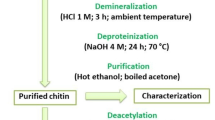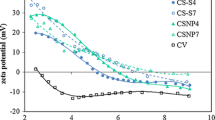Abstract
As there is a large gap in the field of fibre microbiological testing, the successful establishment of appropriate techniques is extremely appreciated. Antimicrobials prevent bacterial cell division by damaging the cell wall or affecting the permeabilities of cells’ membranes; they denature proteins, block enzyme activity, prevent cell survival, etc. Intracellular potassium cations are released by the inhibitions of pathogenic micro-organisms. Their quantitative determination enables monitoring of the bactericidal effect regarding antimicrobials. It can be used as an alternative technique for determining the inhibition of micro-organisms in contact with antimicrobial agents. Chitosan, a biodegradable natural polymer, possesses antimicrobial characteristics that depend on a number of factors such as the protonated amino groups’ quantities, degree of acetylation, molecular weight, solvents, etc. Over recent years chitosan has become extremely attractive for fibre functionalization usage. The aim of this paper was to apply spectrophotometry and potentiometry using potassium ion-selective electrode, respectively, for the quantitative analysis of potassium efflux, resulting from the degradation of micro-organisms’ membranes in contact with chitosan itself, as well as with cellulose fibres functionalised by chitosan.




Similar content being viewed by others
References
Andres MT, Viejo-Diaz M, Fierro JF (2008) Human lactoferrin induces apoptosis-like cell death in Candida albicans: critical role of K+-channel-mediated K+ efflux. Antimicrob Agents 52:4081–4088. doi:10.1128/Aac.01597-07
Cakara D, Fras L, Bracic M, Kleinschek KS (2009) Protonation behavior of cotton fabric with irreversibly adsorbed chitosan: a potentiometric titration study. Carbohydr Polym 78:36–40. doi:10.1016/j.carbpol.2009.04.011
Coman D, Oancea S, Vrinceanu N (2010) Biofunctionalization of textile materials by antimicrobial treatments: a critical overview. Rom Biotech Lett 15:4913–4921
Daoud WA, Xin JH, Zhang YH (2005) Surface functionalization of cellulose fibers with titanium dioxide nanoparticles and their combined bactericidal activities. Surf Sci 599:69–75. doi:10.1016/j.susc.2005.09.038
Gao Y, Cranston R (2008) Recent advances in antimicrobial treatments of textiles. Text Res J 78:60–72. doi:10.1177/0040517507082332
Hammond SM, Kliger BN (1976) Mode of action of polyene antibiotic candicidin—binding factors in wall of Candida-Albicans. Antimicrob Agents Chemother 9:561–568
Hammond SM, Lambert PA, Kliger BN (1974) Mode of action of polyene antibiotics—induced potassium leakage in Candida-Albicans. J Gen Microbiol 81:325–330
Hewitt CJ, Franke R, Marx A, Kossmann B, Ottersbach P (2004) A study into the anti-microbial properties of an amino functionalised polymer using multi-parameter flow cytometry. Biotechnol Lett 26:549–557. doi:10.1023/B:Bile.0000021954.82099.A0
Johnson B, White RJ, Williamson GM (1978) Factors influencing susceptibility of Candida-Albicans to polyenoic antibiotics nystatin and amphotericin-B. J Gen Microbiol 104:325–333
Kim HW, Kim BR, Rhee YH (2010) Imparting durable antimicrobial properties to cotton fabrics using alginate-quaternary ammonium complex nanoparticles. Carbohydr Polym 79:1057–1062. doi:10.1016/j.carbpol.2009.10.047
Knittel D, Schollmeyer E (2006) Chitosans for permanent antimicrobial finish on textiles. Lenzing Ber 85:124–130
Ozer RR, Hill WC, Rogers ME, Evans M (2010) Development of colorimetric analytical methods to monitor quaternary amine grafted surfaces. J Appl Polym Sci 118:2397–2407. doi:10.1002/App.32221
Ristic T, Fras Zemljic L, Novak M, Kralj Kuncic M, Sonjak S, Gunde Cimerman N, Strnad S (2011) Antimicrobial efficiency of functionalized cellulose fibers as potential medical textles. In: Mendez-Vilas A (ed) Science against microbial pathogens: communicating current researchand technological advances. Microbiology book series, 3 edn. Formatex Research Center, Badajoz, p 37–51
Suller MTE, Russell AD (2000) Triclosan and antibiotic resistance in Staphylococcus aureus. J Antimicrob Chemother 46:11–18. doi:10.1093/Jac/46.1.11
Swofford HW (2010) An overview of antimicrobial testing for textile applications. Aatcc Rev 10:51–55
Teufel L, Redl B (2006) Impruved methods for the investigation of the interaction between textiles and microorganisms. Lenzing Ber 85:54–60
Wang Q, Jin GB, Fan XR, Zhao XF, Cui L, Wang P (2010) Antibacterial functionalization of wool via mTGase-catalyzed grafting of epsilon-poly-l-lysine. Appl Biochem Biotech 160:2486–2497. doi:10.1007/s12010-009-8708-7
Watanabe H, Azuma M, Igarashi K, Ooshima H (2006) Relationship between cell morphology and intracellular potassium concentration in Candida albicans. J Antibiot 59:281–287
Zemljic LF, Strnad S, Sauperl O, Stana-Kleinschek K (2009) Characterization of amino groups for cotton fibers coated with chitosan. Text Res J 79:219–226. doi:10.1177/0040517508093592
Zemljic LF, Sauperl O, But I, Zabret A, Lusicky M (2011) Viscose material functionalized by chitosan as a potential treatment in gynecology. Text Res J 81:1183–1190. doi:10.1177/0040517510397572
Zemljic LF, Sauperl O, Kreze T, Strnad S (2013) Characterization of regenerated cellulose fibers antimicrobial functionalized by chitosan. Text Res J 83:185–196. doi:10.1177/0040517512450759
Zemljic LF, Volmajer J, Ristic T, Bracic M, Sauperl O, Kreze T (2014) Antimicrobial and antioxidant functionalization of viscose fabric using chitosan-curcumin formulations. Text Res J 84:819–830. doi:10.1177/0040517513512396
Acknowledgments
We thank the ARRS office in Slovenia (ARRS project L2-4060) which provided financial support for this work. The authors also acknowledge the financial support from the Ministry of Education, Science and Sport of the Republic of Slovenia through the program P2 0118.
Author information
Authors and Affiliations
Corresponding author
Rights and permissions
About this article
Cite this article
Fras-Zemljič, L., Kosalec, I., Munda, M. et al. Antimicrobial efficiency evaluation by monitoring potassium efflux for cellulose fibres functionalised by chitosan. Cellulose 22, 1933–1942 (2015). https://doi.org/10.1007/s10570-015-0605-3
Received:
Accepted:
Published:
Issue Date:
DOI: https://doi.org/10.1007/s10570-015-0605-3




